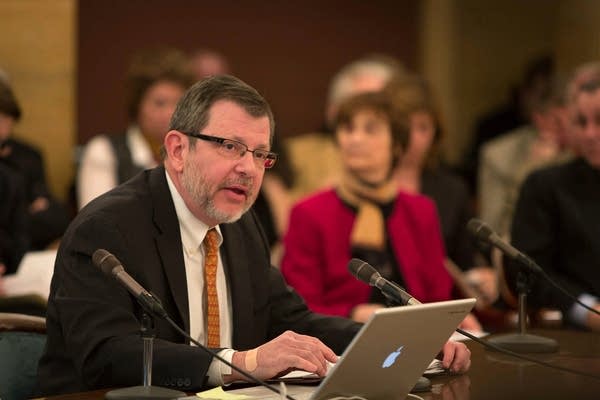U of M seeks state funding; lawmakers want admin. spending answers
Go Deeper.
Create an account or log in to save stories.
Like this?
Thanks for liking this story! We have added it to a list of your favorite stories.

For years, University of Minnesota chemistry professor Bill Gleason has been a vocal critic of university officials and the way they run the school.
One targets of his six-year-old blog, called "The Periodic Table," is what he considers a bloated bureaucracy.
"They've pretty much ignored most of the issues that I have raised," Gleason said.
That changed in December, when the Wall Street Journal reported the university had the largest percentage of managers and administrators among top research universities last year.
Turn Up Your Support
MPR News helps you turn down the noise and build shared understanding. Turn up your support for this public resource and keep trusted journalism accessible to all.
It said the university has hired a thousand administrators in the past decade even as tuition and fees more than doubled, far beyond the average increases among four-year public colleges.
University president Eric Kaler came into office at the end of that period, and he has promised to investigate. But Kaler says the Journal's data and conclusions are off.
Universities report their administrative data inconsistently, so the Journal's comparison wasn't fair. Kaler has pounded home that message in hearings and press conferences.
"Do we have too many people who are doing administrative kinds of things? We're working hard to find that out."
"It was an article written without a lot of context about the university," Kaler said. "It's one that clearly advocated a particular point of view around what drives tuition without focusing on the loss of state aid."
But some legislators have grilled university executives in recent hearings. Senate leaders expect an interim report on administrative spending from the university by March 15.
All this happens as the university also requests $92 million more from the legislature this biennium. University officials say that will enable them to fund research initiatives and enact a two-year freeze on tuition.
The governor has set aside $80 million for that in his budget proposal, but has made it contingent on a satisfactory report on administrative spending.
State officials haven't yet said what would constitute a satisfactory report. And it's unclear how much of the university's budget request the state will ultimately be able to afford, satisfactory report or not.
DFL state Rep. Ryan Winkler of Golden Valley said lawmakers do support students and the university' mission.
"I think what has changed is that there is a lot less confidence by legislators that appropriations sent to the University of Minnesota will feed their primary missions of teaching students and doing research."

For now, Kaler said he is not worried about the issue.
"Do we have too many people who are doing administrative kinds of things? We're working hard to find that out," he said.
Scrutiny of the university's administrative spending comes at a time when public tolerance of high tuition and student debt is at a breaking point nationwide. Almost two-thirds of University of Minnesota students graduate with student loans. The average debt of those university graduates is about $27,000.
Meanwhile, states have decreased higher-ed funding, prompting cuts at universities.
Making the matter worse, were news reports last year that the university paid out more than $2.5 million in separation and transition packages to 10 departing top university executives. Regents revamped executive compensation rules after that.
Mark Misukanis of New Pharos Consulting is the former director of finance and research at the state Office of Higher Education agrees with the Journal's conclusions, and says the current uproar is the most severe reaction he' has seen in 20 years of observing state relations with the university.
Misukanis says administrative expenses aren't the sole cause of high tuition, but they are an understandable target for parents, who then pressure legislators to reform the university.
"They're looking for a reason: Why do I have to borrow against my home in order to simply send my child on to college? What are the issues creating this big increase -- and why are you doing this to me?" Misukanis said. "Very personal. It becomes very personal."
Misukanis says that like many higher-ed institutions, the U tends to build a lot of centers and institutes, which leads to a lot of administrative overhead.
Gleason says parts of the university suffer from a mentality that resembles what he saw during his decade as a senior research chemist at 3M.
"People will brag about their headcount — how many people work for them. The more people who work for them, the better," Gleason said.
State Rep. Gene Pelowski of Winona said past legislatures bear some of the blame.
The DFL chairman of the House higher-education committee said lawmakers have failed to thoroughly question the university's spending in past years.
In his office, Pelowski flips through a hefty volume — one of the proposed higher-ed budgets from the late-1980s.
"It's huge. It's about 151 pages long. It has every change order, a description of what's being funded and what's being changed," Pelowski said. "And this is what we used to do for a thorough understanding of the budget."
Nowadays, he said, such a document would be about 10 pages. Pelowski said he has started to change that by demanding more data and asking tougher questions.
Regents will discuss elements of the university's interim report to the legislature at a regular meeting today.




